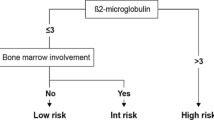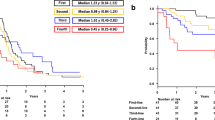Summary
At the last American society of hematology (ASH) meeting new genetic prognostic tools for follicular lymphoma (FL) were presented. Recent clinical data support the potential use of chemotherapy-free combinations in treatment-naïve FL, but potential additive toxicities have to be considered. In relapsed disease the bcl2 inhibitor venetoclax (ABT-199) is very promising in combination with chemo-immunotherapy. Furthermore the concept of CAR-T cell therapy seems to be appropriate in highly refractory disease.
In younger patients with mantle cell lymphoma (MCL) minimal residual disease (MRD) and positrone emission tomography (PET) negativity after induction therapy are highly predicitive for the outcome after autologous transplantation. Bortezomib consolidation/maintenance trials after autologous transplantation yield conflicting results. In relapsed MCL ibrutinib is significantly more effective and also less toxic than temsirolimus.


Similar content being viewed by others
References
Pastore A, Jurinovic V, Kridel R, et al. Integration of gene mutations in risk prognostication for patients receiving first-line immunochemotherapy for folicular lymphoma: a retrospective analysis of a prospective clinical trial and validation in a population-based registry. Lancet Oncol. 2015;16(9):1111–22.
Casulo C, Byrtek M, Dawson KL, et al. Early relapse of follicular lymphoma after R‑CHOP defines patients at high risk for death: an analysis from the national LymphoCare study. J Clin Oncol. 2015;10;33(23):2516–22.
Jurinovic V, Kridel R, Staiger A, et al. A clinicogenetic risk model (m7-FLIPI) prospectively identifies one-half of patients with early disease progression of follicular lymphoma after first-line immunochemotherapy. Blood. 2015;126(23):abstr 333, ASH Annual Meeting Abstracts.
Fowler N, Nastoupil L, de Vos S. Ibrutinib plus rituximab in treatment-naïve patients with follicular lymphoma: results from a multicenter, phase 2 study. Blood. 2015;126(23):abstr 470, ASH Annual Meeting Abstracts.
Ujjani C, Jung SH, Pitcher B, et al. Phase I study of rituximab, lenalidomide, and ibrutinib in previously untreated follicular lymphoma (Alliance 051103). Blood. 2015;126(23):abstr 471, ASH Annual Meeting Abstracts.
De Vos S, Swinnen L, Kozloff M, et al. A dose-escalation study of venetoclax (ABT-199/GDC-0199) in combination with bendamustine and rituximab in patients with relapsed or refractory non-hodgkin’s lymphoma. Blood. 2015;126(23):abstr 255, ASH Annual Meeting Abstracts.
Cheson B, Chua N, Mayer J, et al. Primary results from the phase III GADOLIN study of obinutuzumab plus bendamustine versus bendamustine alone in rituximab-refractory indolent non-hodgkin lymphom. Hematol Oncol. 2015;33(167):abstr 123.
Fowler N, Nastoupil L, Pinto RM, et al. A phase I study of lenalidomide plus a next generation anti-CD20 antibody, obinutuzumab, in relapsed indolent lymphoma. Blood. 2015;126(23):abstr 2742, ASH Annual Meeting Abstracts.
Schuster S, Svoboda J, Nasta SD, et al. Sustained remissions following chimeric antigenreceptor modified T cells directed against CD19 (CTL019) in patients with relapsed or refractory CD19+ lymphomas. Blood. 2015;126(23):abstr 183, ASH Annual Meeting Abstracts.
Le Gouill S, Thieblemont C, Oberic L, et al. Rituximab maintenance versus wait and watch after four courses of R‑DHAP followed by autologous stem cell transplantation in previously untreated young patients with mantle cell lymphoma: first interim analysis of the phase III prospective lyma trial, a lysa study. Blood. 2014;124:abstr 146, ASH Annual Meeting Abstracts.
Le Gouill S, Bodet-Milin C, Bailly C, et al. Predictive power of FDG-PET parameters at diagnosis and after induction in patients with mantle cell lymphoma, interim results from the LyMa-PET project. Blood. 2015;126(23):abstr 335, ASH Annual Meeting Abstracts.
Callanan M, Delfau MH, Macintyre E, et al. Predictice power of early, sequential MRD monitoring in peripheral blood and bone marrow in patients with mantle cell lymphoma following autologous stem cell transplantation with or without rituximab maintenance; interim results from the LyMa-MRD project. Blood. 2015;126(23):abstr 338, ASH Annual Meeting Abstracts.
Kaplan L, Jung SH, Stock W, et al. Bortezomib maintenance (BM) versus consolidiation (BC) following aggressive immunochemotherapy and autologous stem cell transplantation for untreated mantle cell lymphoma: CALGB (Alliance) 50403. Blood. 2015;126(23):abstr 337, ASH Annual Meeting Abstract.
Doorduijn J, Minnema M, Kersten MJ, et al. Bortezomib maintenance therapy after induction with R‑CHOP, ARA-C and autologous stem cell transplantation in newly diagnosed MCL patients, results of a multicentre phase II HOVON study. Blood. 2015;126(23):abstr 339, ASH Annual Meeting Abstracts.
Rule S, Jurczak W, Jerkeman M, et al. Ibrutinib vs temsirolimus: results from a phase 3, international, randomized, open-label, multicentre study in patients with previously treated mantle cell lymphoma. Blood. 2015;126(23):abstr 469, ASH Annual Meeting Abstracts.
Treon S, Tripsas C, Meid K, et al. Ibrutinib in previously treated Waldenström’s macroglobulinemia. N Engl J Med. 2015;372(15):1430–40.
Dimopoulos M, Tedeschi A, Matous J, et al. Ibrutinib therapy in rituximab-refractory patients with Waldenström’s macroglobulinemia: initial results from an international, multicenter, open-label phase 3 substudy (iNNOVATETM). Blood. 2015;126(23):abstr 274–5, ASH Annual Meeting Abstracts.
Kiesewetter B, Greil R, Willenbacher W, Neumeister P, Raderer M. AGMT MALT-2: a phase II study of rituximab plus lenalidomide in patients with extranodal marginal zone B‑cell lymphoma of the mucosa-associated lymphoid tissue (MALT lymphoma). Blood. 2015;126(23):abstr 3973, ASH Annual Meeting Abstracts.
Author information
Authors and Affiliations
Corresponding author
Ethics declarations
Conflict of interest
T. Nösslinger declares that he has no competing interests.
Rights and permissions
About this article
Cite this article
Nösslinger, T. Indolent lymphoma at ASH 2015: new treatment approaches. memo 9, 120–123 (2016). https://doi.org/10.1007/s12254-016-0274-4
Received:
Accepted:
Published:
Issue Date:
DOI: https://doi.org/10.1007/s12254-016-0274-4




